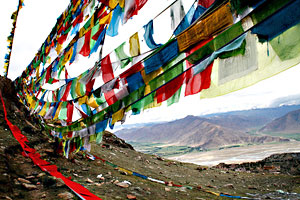|
Culture of Tibet
Tibet has the richness and the depth of its traditions that is
deep rooted in its cultural heritage. The wisdom, knowledge
about life, compassion, tolerance and peace of mind, all
contribute in making the culture of Tibet. The simplicity of
life, the spirituality of minds and rich customs and
traditions give a strong hold to this alpine region. |
|
The
most stunning part of Tibetan culture is its performing
arts. Every Tibetan can sing and dance. Be it music,
dance or drama, they all have been unimaginably
impervious to western influence. They purely reflect the
cultural heritage of trans-Himalayan region. Unlike
other countries, the music and dance here is not mainly
for entertainment, but most of the songs here are
religious, reverberating the influence of Buddhism on
Tibetan culture. The singing style of Tibetan's is quite
peculiar and their songs are sung from throat in a
different way that |
 |
|
|
makes the
sound echo in the valley and can be heard even from long
distances. The people of Tibet consider it as one of the
medium of spreading their beliefs and religion as far as
possible.
But dances definitely have an entertainment
edge as well to them. They are generally performed during
various festivals or any personal celebrations. Dances like
Guoxie, Duixie (Tibetan Tap dance) and Quamo dance make the
prominent part of every cultural event in Tibet.
The impact of Buddhism religion, which is the most widely
practiced religion, can be seen on almost every thing in
Tibet. The people of Tibet take their religion, beliefs and
values very seriously. In the past, every family was expected
to send at least one boy to monastery which were religious
centers imparting education. Even though the economic
stability of Tibetans has increased many folds but still many
people go to these monasteries for their studies.
Art is probably the most visible form of religion in Tibet.
The Paintings and craft works are deeply religious in nature.
They are inspired by almost all religious beliefs, Mahayana
Buddhist, Tantric influence, Bon influence. The most amazing
pieces of art works can be seen in the Thangka paintings, Wood
prints and cliff paintings. The cliff paintings in Tibet are
said to be ongoing from pre historic times.
Buddhism Religion in Tibet
Buddhism died out in India around 1200 BC, as Hinduism revived
and various invasions destroyed Buddhist centres. But Buddhist
doctrines and scriptures lived on in Tibet, where Buddhism was
promoted by the kings. The faith almost vanished with the end
of the monarchy in the ninth century. When it arose again,
Tibet's decentralized conditions allowed Buddhism to split
into some 20 sects.
The following five sects became the most important:
Nyingmapa
Nyingmapa, the ancient sect, began around 750 AD with
Padmasambhava. It absorbed the Bon faith and produced the
Tibetan book of the dead.
Kahdampa
Kahdampa Sect began with Atisha after 1050 AD. Its tradition
laid stress on the scriptures and discipline, and it formed a
link with India's sages.
Kagyupa
Kagyupa Sect began around 1060 AD with the teachers of Marpa
and Milarepa. Most typically Tibetan, it stressed yoga as the
way to seek enlightenment.
Sakyupa
Sakyupa Sect arose in 1073 AD at sakya monastery, which later
governed Tibet. It was worldly and practical and less
concerned with metaphysics.
Gelugpa
The Gelugpa Sect or virtuous ones or yellow hats, began with
Tsong Khapa in 1407 AD. It absorbed Kahdampa Sect and carried
on Atisha's tradition. It dominated Tibet after the 17th
century, leaving other sects to play a minor role.
|